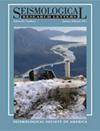运动学破裂模型的地震动变异性及其对非遍历概率地震危险性分析的影响
IF 2.6
3区 地球科学
Q2 GEOCHEMISTRY & GEOPHYSICS
引用次数: 0
摘要
地震地面运动的可变性对概率地震危险性分析(PSHA)具有很强的控制作用,特别是对于用于关键设施的低频率超过。利用交叉混合效应模型对瓦萨奇断裂带盐湖城段7级地震模拟地面运动的方差分量进行了划分。模拟地面运动的总变率与经验模型大致相当。破裂速度的高贡献表明,通过研究特定断层的破裂速度的原因和预测,可以减少变异。模拟结果表明,由指向性效应引起的变率具有很强的空间异质性。我们使用部分非遍历PSHA框架来说明这种空间异质性对危害的影响。结果强调了在非遍历PSHA中考虑指向性效应的好处,其中考虑控制地面运动的附加过程的模型与模拟的地面运动变异性的减少相匹配。本文章由计算机程序翻译,如有差异,请以英文原文为准。
Ground-Motion Variability from Kinematic Rupture Models and the Implications for Nonergodic Probabilistic Seismic Hazard Analysis
The variability of earthquake ground motions has a strong control on probabilistic seismic hazard analysis (PSHA), particularly for the low frequencies of exceedance used for critical facilities. We use a crossed mixed-effects model to partition the variance components from simulated ground motions of Mw 7 earthquakes on the Salt Lake City segment of the Wasatch fault zone. Total variability of simulated ground motions is approximately equivalent to empirical models. The high contribution from rupture speed suggests an avenue to reducing variability through research on the causes and predictions of rupture speed on specific faults. Simulations show a strong spatial heterogeneity in the variability that manifests from directivity effects. We illustrate the impact of this spatial heterogeneity on hazard using a partially nonergodic PSHA framework. The results highlight the benefit of accounting for directivity effects in nonergodic PSHA, in which models that account for additional processes controlling ground motions are paired with reductions in the modeled ground-motion variability.
求助全文
通过发布文献求助,成功后即可免费获取论文全文。
去求助
来源期刊

Seismological Research Letters
地学-地球化学与地球物理
CiteScore
6.60
自引率
12.10%
发文量
239
审稿时长
3 months
期刊介绍:
Information not localized
 求助内容:
求助内容: 应助结果提醒方式:
应助结果提醒方式:


